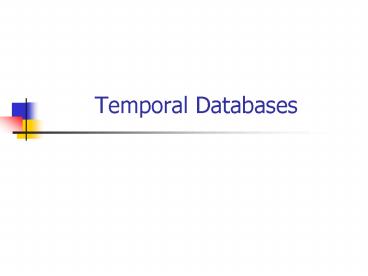Temporal Databases PowerPoint PPT Presentation
1 / 21
Title: Temporal Databases
1
Temporal Databases
2
Outline
- Spatial Databases
- Indexing, Query processing
- Temporal Databases
- Spatio-temporal
- .
3
Temporal DBs Motivation
- Conventional databases represent the state of an
enterprise at a single moment of time - Many applications need information about the past
- Financial (payroll)
- Medical (patient history)
- Government
- Temporal DBs a system that manages time varying
data
4
Comparison
- Conventional DBs
- Evolve through transactions from one state to the
next - Changes are viewed as modifications to the state
- No information about the past
- Snapshot of the enterprise
- Temporal DBs
- Maintain historical information
- Changes are viewed as additions to the
information stored in the database - Incorporate notion of time in the system
- Efficient access to past states
5
Temporal Databases
- Temporal Data Models extension of relational
model by adding temporal attributes to each
relation - Temporal Query Languages TQUEL, SQL3
- Temporal Indexing Methods and Query Processing
6
Taxonomy of time
- Transaction time databases
- Transaction time is the time when a fact is
stored in the database - Valid time databases
- Valid time is the time that a fact becomes
effective in reality - Bi-temporal databases
- Support both notions of time
7
Example
- Sales example data about sales are stored at the
end of the day - Transaction time is different than valid time
- Valid time can refer to the future also!
- Credit card 03/01-04/06
8
Transaction Time DBs
- Time evolves discretely, usually is associated
with the transaction number - A record R is extended with an interval t.start,
t.end). When we insert an object at t1 the
temporal attributes are updated -gt t1, now) - Updates can be made only to the current state!
- Past cannot be changed
- Rollback characteristics
T1 -gt T2 -gt T3 -gt T4 .
9
Transaction Time DBs
- Deletion is logical (never physical deletions!)
- When an object is deleted at t2, its temporal
attribute changes from t1, now) ? t1, t2) (i.e.
it updates its interval) - Object is alive from insertion to deletion
time, ex. t1 to t2. If the value is now then
the object is still alive
eid salary start end
10 20K 9/93 10/94
20 50K 4/94
33 30K 5/94 6/95
10 50K 1/95
time
10
Transaction Time DBs
id
Database evolves through insertions and deletions
11
Transaction Time DBs
- Requirements for index methods
- Store past logical states
- Support addition/deletion/modification changes on
the objects of the current state - Efficiently access and query any database state
12
Transaction Time DBs
- Queries
- Timestamp (timeslice) queries ex. Give me all
employees at 05/94 - Range-timeslice Find all employees with id
between 100 and 200 that worked in the company on
05/94 - Interval (period) queries Find all employees
with id in 100,200 from 05/94 to 06/96
13
Valid Time DBs
- Time evolves continuously
- Each object is a line segment representing its
time span (eg. Credit card valid time) - Support full operations on interval data
- Deletion at any time
- Insertion at any time
- Value change (modification) at any time (no
ordering)
14
Valid Time DBs
- Deletion is physical
- No way to know about the previous states of
intervals - The notion of future, present and past is
relative to a certain timestamp t
15
Valid Time DBs
The reality best know now !
16
Valid Time DBs
- Requirements for an Index method
- Store the latest collection of interval-objects
- Support add/del/mod changes to this collection
- Efficiently query the intervals in the collection
- Timestamp query
- Interval (period) query
17
Bitemporal DBs
- A transaction-time Database, but each record is
an interval (plus the other attributes of the
record) - Keeping the evolution of a dynamic collection of
interval-objects - At each timestamp, it is a valid time database
18
Bitemporal DBs
19
Bitemporal DBs
- Requirements for access methods
- Store past/logical states of collections of
objects - Support add/del/mod of interval objects of the
current logical state - Efficient query answering
20
Temporal Indexing
- Straight-forward approaches
- B-tree and R-tree
- Problems?
- Transaction time
- Snapshot Index, TSB-tree, MVB-tree, MVAS
- Valid time
- Interval structures Segment tree, even R-tree
- Bitemporal
- Bitemporal R-tree
21
Temporal Indexing
- Lower bound on answering timeslice and
range-timeslace queries - Space O(n/B), search O(logBn s/B)
- n number of changes, s answer size, B page
capacity

